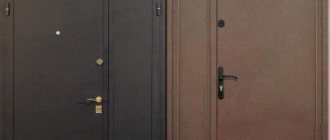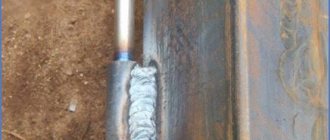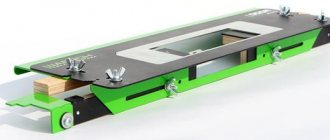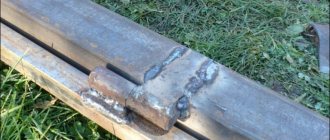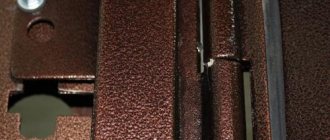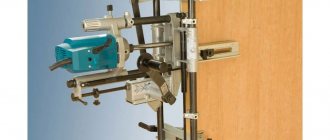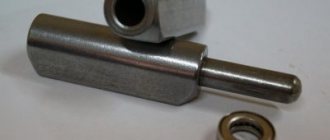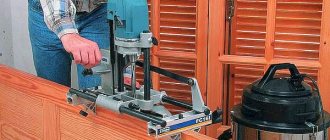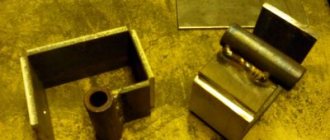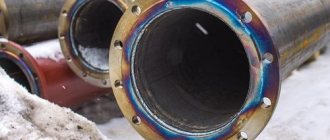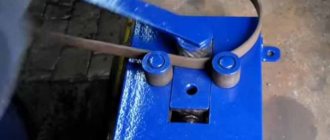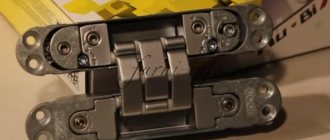Their reliability and service life depend on how the hinges are welded on or in the yard. The same can be said about. In this case, it is necessary to take into account the design features and characteristics of the material from which they are made. For example, when welding hinges of small thickness, you can accidentally burn through the skin or warp the frame.
The choice is made taking into account the size and weight of the valves. For example, a metal garage door will require stronger hinges with a support bearing than a gate. The stores offer a variety of types:
- Drop-shaped ones with support bearings are designed for weights up to 400 kg.
- Cylindrical, thanks to the amplifier, which works as a load distributor, and the support bearing, ensure ease of opening with a load of up to 600 kg.
- Through ones are chosen if it is impossible to weld the hinges or secure them with bolts. Fixation is carried out using a through hole in the rack. They are attached to the sash with nuts. Maximum load up to 200 kg.
- 3-section doors are difficult to break into and are used for hanging heavy sashes.
- Forged ones are functional and are used as decoration for wooden gates.
- Steel boom hinges are often installed on garage doors made of thick metal.
- Height-adjustable hinges are useful if the position of the support posts may change.
Correctly welding the hinges with your own hands
To ensure that the structure does not sag under its own weight and opens conveniently, properly welded hinges on the gate must meet the following requirements:
- welds are made continuous;
- if possible, the loops are welded around the entire perimeter;
- so that the canopies are not subjected to additional loads, they are installed as level as possible;
- When hanging heavy sashes, install additional hinges.
We weld the ears
An inexperienced craftsman may not have the ability to reliably weld hinges with a cylindrical body to a flat surface. In this case, metal plates called plates or ears are used. They are welded to the hinges in the following order:
- Two plates are placed parallel to a flat surface with a gap between them of 2 - 3 mm;
- A loop is placed in the gap;
- The plates are welded with a continuous seam to the cylindrical body. One to the top of the loop and the other to the bottom.
Features of welding hinges to round, square and stone pillars
In order for the gate to function without jamming, you need to weld the hinges to the round posts through metal substrates 2 - 3 mm thick. The installation location of the canopies on the rack needs to be moved 5 - 6 mm outward. This will ensure maximum opening of the valves.
The hinges are installed flush with the outside of the square supports. At first they are only grabbed. Then, using a wooden block or corner, vertical alignment is carried out, controlling it with a plumb line. If, after preliminary hanging of the gate, nothing interferes with its opening, final welding is performed.
A metal pipe is placed inside the stone pillars intended for hanging gates. Mortgages are welded to it for installing hinges. If the concrete or stone pillar is without mortgages, the canopies are secured using rods driven or screwed into the holes. For massive gates on brick and stone fences, channels installed on columnar foundations are used as supports.
To weld hinges on the fence and gates, a pair of jumpers is prepared from a profile sheet. They are installed parallel to the long sides. The distance between them is chosen so that three jumpers fit. After fastening, the hinges are welded at the bottom and top. To avoid damage by welding, the corrugated sheet is screwed over the installed canopies. For reliability, it is recommended to weld garage hinges that can withstand significant loads.
We try on the gate and make markings
The finished sashes are installed in the opening and aligned with the level gauge. At a distance of about 20 cm from the top and bottom edges, mark where the hinges need to be welded. If the weight of the sashes exceeds 200 kg, another canopy is installed at the top. After marking with a plumb line or laser level, the vertical position of the hinges is checked so that there is not the slightest distortion, otherwise they will quickly wear out.
We weld the hinges to the gate
Rust and dirt are removed from awnings. They are then coated with grease or a similar lubricant to prevent caking during welding. To ensure smooth operation, metal plates up to 5 mm thick are placed under the round hinges. The awnings are first secured to the sashes and then to the supports. If, after checking the opening and closing, no flaws are found, final welding is carried out. Installation of hinges on metal doors and gates is done according to a similar scheme.
- It is better to install hinges on garage doors by placing them on the ground;
- vertical seams are made from the bottom up, preventing molten metal from draining;
- For convenient closing of the valves, a backing is placed under the bottom hinge before welding.
The process of welding hinges is simple, but you should not rely on the accuracy of your eye. It’s better to double-check with measuring instruments seven times so that you don’t have to redo everything. Haste when testing the gate, without waiting for the welds to cool completely, will also lead to the work being repeated.
Methods for welding hinges on door and gate frames. There are a lot of masters and each is right in his own way. I want to show one of the options, which, in my opinion, is the most well thought out, reliable and not difficult to manufacture even for those who are just starting to make doors. These photos show how the hinge is located. The gate leaves are made of a 25x40x2 profile pipe. I usually make the frame and gate box from a 63×4 corner, if you have 50×3, it will also work.
Pay attention to the gap between the sash and the frame; I have embedded plates for this purpose. Before welding the hinges, you need to set a gap of 1.5 mm on the hinge side between the sash and the frame, and on the upper and lower horizons of the frame there should be at least a 10 mm gap between the sash and the frame. As you can see in the photo, I make the embeds for the hinges from the same 63×4 corner; I weld the embedded corner tightly to the sash, from below and from above, at a distance of 200 - 250 mm. After this, I attach the hinges, not forgetting to place a 1 mm plate for a small gap between the frame and the hinge, using a rule or any other metal strip, we check the alignment of the hinges by first placing them on the top of one side. After making sure that the hinges are aligned, you can begin welding. When welding, the hinges pull specifically, purely for myself, I learned the method of attaching small tacks to each part of the hinge. Along the edges then the center, then each part of the hinge. And only after that scald it properly. Why am I describing this particular method in this article? Usually the hinge is welded at the junction of the frame and the sash. If you shift the center of the hinge on the frame, the sheet that is welded to the sash will have a greater overlap than in the case where the hinge is welded at the joint. In the photo you can clearly see the overlap, about three centimeters; with other options, such an overlap on the frame was obtained only along the upper and lower horizons and on the gate vestibule in the center. We weld the cladding sheet to the sash using clamps, at points at intervals of 150 - 200 mm. Now let's pay attention to the bulging of the sheathing sheet in the places where the hinge is embedded on the sash, which we made from a 63x4 corner. This is clearly visible in the photo. We will need the same corner 63 or a powerful chisel. With God's power we begin to straighten. To make it convenient to hold the corner with the shelf down, you can weld a handle in the form of a rod or fitting. A couple of good blows with a sledgehammer and the result is obvious. I usually use 2mm smooth cold rolled sheet. If you use a 3 mm or 4 mm sheet, it would be better to heat it with a gas burner in these places before straightening. If you follow the recommendations described above, you can make a gate in three or four hours. I hope this method will be useful to you.
To weld a gate with your own hands, you will need basic electric welding skills, which will allow you to lay a short seam and assemble the structure. The most common method is welding a gate from profile pipes.
Assemble a simple frame and sew it up with any material. Regardless of the beauty of the design, it has a number of advantages compared to gates made from other materials.
The gate can be made from a corner, but the profile has a number of advantages. The design made from it has a large margin of safety. For such a wicket this quality is especially important. It is subjected to not only static loads, but also dynamic loads during repeated daily openings.
The profile pipe is inexpensive in comparison with other types of rolled metal with the same technical characteristics. With good processing after welding, the structure will serve for a long time.
Using squares you can make a gate of any configuration. It can be solid, sewn with multi-colored durable corrugated sheets, flat slate, or “cards” made of sheet metal. The gate is decorated with forging elements or simply sheathed with metal mesh and profile sections.
The design itself is quite simple to manufacture using electric welding.
Two pillar parts must be welded with 3 cross members and covered with corrugated sheeting. The only difficulty is welding and installing the hinges.
If you manage to weld a gate, then you will be able to weld other frame structures for your home.
It is possible to manufacture a gate without welding. The parts are secured to brackets and bolts. But welding is a more reliable and durable option.
Classification according to GOST
Today on the market you can find a huge number of all kinds of hinges from different manufacturers, shapes, types of fastening, and external design. High-quality hinges for country gates and gates are divided into certain groups according to current GOSTs so that the average person does not get confused when choosing them. This makes it much easier for customers to select the necessary components and navigate their types and prices. Knowing the features of each type, the client can easily choose the right part for fastening the doors.
The main types of hinges for modern gates are the following:
- cylindrical type with support bearing;
- secret type for hidden installation;
- through-type curtains;
- models with a reinforced structure for mounting on gates;
- three-section type for installation in industrial facilities.
Now, let's take a closer look at each of these types in order to evaluate the features of each of them.
Cylindrical with support bearing
This type is made in a standard form and is not particularly different. Outwardly, they look like a cylinder of two halves. In the first part, which is the top, there is a pin, and in the second, which is the bottom, there is a hole into which the first part is inserted. Some models have a ball-type bearing inside to facilitate movement.
Such curtains are used in structures whose weight does not exceed 400 kilograms. For heavier systems, reinforced special cylindrical hinges are used. The connectors are fastened by welding. The ball bearing is installed in the hole in the lower curtain. Often, on the back side of the bearing there is a hole with a plug that makes it easy to lubricate and clean it. This small revision will improve the performance.
Up to four cylindrical hinges are installed in such structures to ensure the best movement and reduce the load on each. In some models, the bearing is not installed in the lower part, but between two moving elements. This modification greatly simplifies the opening and closing process. However, such a mechanism is difficult to lubricate, since to do this you need to lift one of the flaps.
Secret hinges
The main advantage of this type is hidden installation, because the design reliably hides them inside when the system is closed. A special feature of the design is that the hinge itself is hidden in the sash frame and attached to the side of the support. The advantage of such a fastening system is that it reduces the chances of hacking, because the loop is difficult to find and almost impossible to dismantle without the necessary tools.
Through-type hinges
The design feature of this type is that the two curtains are connected by a rod that enters the upper part and protrudes slightly from the lower part. The simplest design consists of two halves and a pin. This type is widespread on the market and is used mainly for office doors; the design can withstand a weight of up to 200 kilograms.
Assembling elements is somewhat reminiscent of a construction set, because each element has several ears
It is important to note that there can be several such elements on the door, which significantly increases reliability. Sometimes, bearings are installed between the hinge elements, allowing movement to occur more smoothly, with less effort.
If the plug is not provided for by the design, then a special limiter is installed on the top part, which does not allow the pin to be removed. This prevents hacking without special tools.
Reinforced gate models
Special reinforced models of cylindrical hinges allow them to withstand greater loads than conventional ones. They are made of metal of greater strength, as a result of which the walls and rods are thicker. This allows you to increase the load-bearing capacity of each loop.
This type has modifications in which bearings are added. They have special markings that indicate increased wear resistance and maximum pressure on them. This makes it easy to open and close heavy gates.
Three-section industrial
This type is in great demand in structures with significant weight of the connected web. Structurally, they are similar to through models, however, they are more reminiscent of cylindrical ones. Their design consists of two oppositely directed pins onto which cylinders are placed and welded to the posts.
Dimensions and shape
You can weld the gate in the form of an arch, an ellipse or any other shape. The most popular shape is rectangular with several jumpers to fasten the pillar parts and add rigidity. Installation together with poles is possible, but most often the gate is hung on the hinges of already standing poles.
Common dimensions of parts for the simplest design: height 2100 mm, width varied, depending on the installed pillars.
Older households had rather narrow and inconvenient gates, so you may have to make changes to the fence by moving the posts and widening the opening. As a rule, the entrance is made 1000 mm wide.
Materials
The pillars are made from profile pipes with shelf sizes of 80 or 100 mm. Taking into account its lowering into the ground by 800 mm, the length of the pillars should be 3 m. Plugs are welded to the upper ends to prevent water from entering.
For greater rigidity and securing the rack, you can weld small pieces of reinforcement or other rolled steel, 1 m long, on the section extending into the ground.
For standing ones, take a 40/40 or 40/60 profile, cut off two parts with a length of 2100 mm using a grinder. The edges of the pipes are cut at an angle of 450 for a larger welding area and reliable fastening.
The upper and lower lintels are prepared from the main profile, with a gate width of 1000 mm. parts are cut to size 980 mm. This will provide a gap of 10 mm between the loot and the gate on each side. Cut the edges at an angle of 450.
For the middle lintel you can take a 25/40 profile, its length should be 900 mm, it will be inserted inside the frame, so the width of 2 profile shelves is subtracted from the total length of the workpiece, in this case it is 80 mm.
You will need 2 hinges with an outer diameter of 30 mm and 4 steel plates with a thickness of 5 mm and a width of 40 mm. The hinges must be disassembled and the internal surfaces well lubricated with grease or other thick lubricant, then assembled. It is better to purchase loops with balls.
The plates are laid out on a flat surface and loops are attached to each part from different sides. That is, if a plate is attached to the part of the loop with a hole from the outside, then on the mating part the plate is placed towards the inside.
Welding is mandatory on both sides to ensure welding of the root of the seam. After the first pass, you need to beat off the slag and weld the second pass. At the root, welding is performed in one pass.
Creating a Project
Initially, the owner needs to decide whether the product will be swinging or sliding. Swing gates are easier and faster to make. Sliding models are more difficult to build: the work is complicated by rollers that must be correctly installed in the profile.
The product cannot be installed blindly; for this purpose, a competent drawing must be created. There are several options: ask for help from a familiar specialist who will quickly deal with the matter, use a sheet of paper and draw diagrams, or make them using a graphics editor. If the owner does not have the skills to use the program, then it is not worth doing the project on a computer, because this will take a lot of time.
Step-by-step design:
- If a car enthusiast has no desire to engage in drawing, then he can use ready-made diagrams on the Internet. It is enough to adjust the dimensions of the opening to the option of interest.
- In addition to the drawing, a design sketch is made. No artistic skills are needed here, just a simple image is enough.
- After drawing, the owner creates a list of materials, dimensions, dimensions of the opening, and parameters of the sashes on a separate sheet of paper. For example, 4 profile pipes with a wall thickness of 3 mm, of which the first two are 200 cm long, the others are 300 cm long.
- Experts advise making an estimate that indicates the financial costs for certain types of parts. This also includes the price for delivery of building materials.
In order not to walk around the market for a long time in order to find out the prices for this or that material, the owner just needs to ask his neighbors or friends who installed welded garage doors about the amount spent on purchasing metal.
Tools for work
When all the main parts of the gate are ready, you should decide on the lock and handles. If necessary, you will need to weld brackets to attach the handle from the inside.
- welding machine;
- electrodes for welding steel grades MP-3 or ANO-21;
- hammer, sledgehammer;
- protective clothing and welding mask;
- building level or simple plumb line;
- trowel or spatula;
- several sections of pipe, 1000 mm long, for lintels when concreting pillars;
- concrete solution;
- For installation and welding of hinges, embedded parts are prepared to provide gaps between the gate, hatch and floor.
Having prepared all the materials and tools, we begin to manufacture and install the gate.
Installation and concreting of pillars
Based on the size of the opening, mark the installation locations of the pillars and use a hand drill to make a hole in the ground 80 mm deep. Then the profile is lowered into the holes and set in a strictly vertical position using a level or plumb line.
Special attention should be paid to this operation. The correctness of the entire installation of the gate depends on it. The pillars are fastened together with spacers and additionally each with jibs, filled with concrete, not forgetting to compact it when pouring. Now the concrete needs to be allowed to harden for 24 hours.
Frame welding
Welding can be done first, and then installing the pillars, but it can also be done the other way around. It will not take much time to weld the structure. The pillar parts and lintels are laid out on a flat surface.
They are set according to level. Connect the pillars and the top jumper. Place 2 potholders on each rack on the outside and sides. The lower part is grabbed in the same way.
Use a tape measure to measure the diagonal. A 2 mm skew on the side is allowed, but it is better to do it without skew. Having set the diagonal, they grab it from the outer end surface of the joints. Mark and grab the additional strut of the structure. It should be flush with the surface of the racks.
The entire structure is scalded on all sides. The front side of the gate, on which the lining will be attached, is cleaned with a grinder. All other joints are hammered and the quality of the weld seam is checked.
If the pores are large, scald these areas again. Now you can clean up the uneven joints a little without disturbing the seam. The wicket structure is ready.
It is necessary to weld the hinges onto the gate frame. This can be done when hanging it on poles, but welding in the lower position will provide a better quality seam.
For welding, mark the same distance from the edge of the structure, align the hinges coaxially to each other and the gate, and grab them in several places. Once again check that the hinges are installed correctly and weld them on both sides.
Hanging on poles
After allowing the concrete to cure, they begin to install and secure the street door. Remove the spacers from the tray. Using mortgages, set the position of the gate between the pillars, maintaining the gaps.
At the bottom, to prevent rubbing when the structure sag, a gap of 100 mm is made. This will provide ventilation to the yard and prevent scuffing. Check the correct installation in all planes and begin welding the hinges.
The plates on the mating part of the loop are placed on the pole. Now follows from all sides of the plate. We remove the embedded parts and check the operation of the gate. It should work easily without scuffing.
Sheathing
If you are sewing up the gate with mesh or rods, they should be secured before installing them on the posts. When laying a sheet of corrugated sheets, it should be fastened after welding. The corrugated sheeting is secured with self-tapping screws, the heads of which are covered with decorative overlays.
Without high-quality welding, the gate will not last long. For reliability, be sure to check the filling of the seam with molten metal.
Before welding, double-check that the part or the structure as a whole is installed correctly. Take your time.
Before sheathing with corrugated sheets, be sure to degrease all surfaces and first apply a primer and then paint that matches the color of the decorative coating of the gate and fence.
Having completed all the work on welding and installing the gate correctly and efficiently, you gain invaluable experience in the manufacture of frame structures.
Gate hinges are a simple device that serves to attach gates to posts, as well as for easy opening and closing. The reliability of the design and ease of operation depend on the choice of this mechanism.
They are mainly equipped with hinges, which can be quite heavy. Therefore, special attention must be paid to the quality of installation, namely the fastening of hinges. A person who knows how to handle electric welding can weld hinges on the gate themselves, but those who do not have such skills are recommended to turn to professionals.
Varieties
Hinges allow you to smoothly open and close the gate without making a single sound
All types of loops can be divided into three groups:
- classic;
- decorative;
- hidden.
The first ones have a normal appearance, because the consumer encounters them quite often, since they are installed on entrance and interior doors. Even though we are talking about gate hinges, they are not particularly different. In this case, there is one aspect that plays an important role, this is the special treatment of the material, thanks to which the hinges will withstand any weather conditions.
Increased reliability is one of the most important characteristics during hinge production. This element must withstand heavy loads, because the gate is heavy and is also used regularly. Therefore, additional bearings are often installed to improve the data. You can often find hinges without ears on sale, since the consumer can independently weld them to the product, depending on the structure of the system.
Articulated
Hinges are in great demand and this can be reasonably explained. They allow you to easily and smoothly guide the gate and are resistant to breakage, which is an important indicator. Some of the hinges of this device are designed for installation on large gates, as they can withstand heavy loads. Spontaneous opening and closing is excluded if the structure itself is installed correctly and this fitting option is selected.
For the manufacture of hinges, durable and reliable metal is used, which has excellent performance. Heavy gates will last a long time with this installation.
Hidden
They resemble classic ones, but the main advantage is their increased burglary resistance, and for many this is the main indicator. Removing such gates will be problematic and will also take a lot of time.
Decorative
According to the principle of operation, they do not differ from the classic ones, but they look more aesthetically pleasing and can emphasize the design of the gate installation. Hinges can be antique, forged, or in a certain style. Welded structures are strong, reliable and provide safety.
teardrop-shaped
They take their name from the shape of the bearings, which are an integral part of the structure. Such hinges are in demand during the installation of garage and entrance gates, steel doors and even safes. Thanks to the teardrop shape, the problem of uneven movement is solved, so if you have heavy swing gates, this option will be one of the best. When opening, you will not hear creaking or noise, the structure will move smoothly.
Cylindrical
They are suitable for a massive frame where strength and resistance to heavy loads are required. They have support bearings that do their job for a long time. In such hinges the crown will be hidden in the body.
Adjustable
This type of hinge is distinguished by its ability to be adjusted, which is an indispensable advantage in certain situations. Thanks to them, you don’t have to worry about the sashes jamming. As for the cost, it all depends on the variety you have chosen, as well as the manufacturer, because everyone sets their own prices.
Welding rules
In order to prevent the gate from sagging and to avoid problems with its operation in the future, all work must be carried out taking into account certain features. Therefore, first of all, special attention should be paid to:
- The integrity of the weld, which must be continuous, that is, without gaps.
- Welding depth - the loop must be welded along the entire plane adjacent to the support.
- Axial location - all hinges on the sash must be in one straight line so that the load on the seams is distributed evenly.
- When determining the number of hinges, if the gate is massive, it is recommended to supplement the design with another pair.
- Dimensions - all measurements are made using tools designed for this purpose, and not “by eye”.
Selection of corrugated sheets
Corrugated sheets differ among themselves in thickness, degree of strength and rib height.
- “C” is a lightweight and durable galvanized wall sheet with low thickness and rib height. The most common choice;
- “NS” is a denser profiled sheet with a higher rib height, but also heavier;
- “N” is a massive load-bearing corrugated sheet, used for roofs of a huge area. Not suitable for gates due to heavy weight and high cost.
The best choice would be a profiled sheet of grade C8 or C10. The number indicates the height of the wave in centimeters. The thickness of the sheet of this brand is from 0.4 to 0.8 mm. Sashes made from grade C corrugated sheets will weigh from 25 to 40 kg, so they can easily be hung by two people, without the use of special lifting equipment. Due to the fact that one profiled sheet per sash will not be enough, the size is calculated based on the width of the material.
Welding technology
It will be much easier to weld the hinges correctly if you follow the rules of the sequence of the technological process. The sequence of work is as follows:
- installation of plates;
- gate installation;
- welding of hinges.
Now we will analyze each of the stages separately, using the example of circular loops (turned).
Video: How to properly weld hinges with your own hands.
Installation of plates
Platik is a metal mounting plate that serves both to distribute the load evenly and to simplify welding work. The size of the plate and its shape depend on the weight and dimensions of the valves.
It turns out that in order to correctly install the loop, you need to weld such a plate to it. This is done with a continuous seam, without gaps. Experienced welders can weld without plates, which is quite acceptable, but the fastening will not be as reliable.
Cinder block garage
Garage made of cinder block
Cinder block can be different, for example:
- shell rock;
- blast furnace slag;
- brick fight.
Their durability has been tested by time - they are even used to build houses in warm climate regions, not to mention garages. To strengthen the slabs themselves, manufacturers add polystyrene, perlite and various useful components to the composition.
The only drawback of cinder block is its sensitivity to moisture. Therefore, for areas where groundwater flows, it does not serve for a long time; there it is better to choose another material. Unfortunately, a budget cinder block cannot even be varnished like wood.
How to build a cinder block building
The technology for constructing a garage cheaply with your own hands from cinder blocks is in many ways similar to the process of building from wood:
- clean and level the area, while you should have a plan of the future building in your hands;
- install a strip foundation, for which you dig a trench around the perimeter to a depth and width of about half a meter, lay a brick-sand cushion, reinforcement and fill it with cement.
- After waiting a month, build walls;
- complete the screed;
- install the roof;
- attach the gate.
Some tips:
When erecting walls, the corners are first made, cords are stretched between them, thanks to which the evenness of the structure is ensured. The floor is screeded with about 10 cm of concrete grade M200.
All you have to do is wire the electricity and then finish the inside of the garage.
Gate installation
Before welding the prepared hinges, it is necessary to install the gate in the opening. This must be done in the way they should be on a permanent basis. For installation, use a long building level or plumb line.
The gates are aligned in all planes: vertically, horizontally. Only after making sure of their correct location several times can you move on to the next stage.
Welding hinges
This process seems complicated only at first glance, but with a little practice you can do everything yourself.
This is done as follows:
- The hinge is lubricated with automotive lubricant (solidol, lithol, etc.), this contributes to their smooth and easy operation after installation.
- Thin linings up to 5 mm thick are prepared; this is mainly required for turned hinges.
- Markings are made - the loops should be located at a distance of 30 cm from the top and bottom.
- The hinges are welded in several places, first to the sashes and then to the pillars. After checking for closure and opening, welding continues until a solid, even seam is formed.
- After the seams have cooled, they must be sanded and primed or painted.
This technology is used by almost all door installers.
Incorrect welding can lead to problems during further operation; to prevent this from happening, you should listen to the following recommendations:
- Before starting work, make and study a schematic drawing; if all the details are taken into account in advance, then the risk of redoing the finished structure will be much less;
- straight hinges are welded to the gate laid on a flat surface;
- You can open gates with newly welded hinges after the seams have completely cooled;
- on round posts the loop extends 5 mm outward, on rectangular posts it is welded flush;
- the welding seam should go from bottom to top.
How to weld the hinges yourself
Welding hinges is not an easy task, especially for beginners. But, if you have patience and desire, you can cope with such work even in the absence of serious experience.
To work you will need the following tools:
- metal tape measure;
- level;
- hammer;
- welding machine;
- Sander;
- special mask;
- gloves for welding work.
Rules:
- When working with a welding machine, you must strictly follow safety rules. A protective mask and gloves must be used.
- In accordance with fire safety standards, welding is prohibited near flammable liquids and objects.
- When hinges are welded to the gate, they need to be lightly “grabbed” by welding.
- Since the hinges are welded to the door leaf, when drawing up the drawing, you need to take into account that the distance from the lower edge of the leaf to the lower hinges, as well as from the upper edge to the upper hinges, must be at least 20 cm. On the wings, the place where the hinges are attached is marked with a pencil.
- Fasteners should be thoroughly lubricated with grease. This measure will protect them from cracking when exposed to high temperatures.
- It is believed that if a match is placed along the edges of the hinges, the door will not jam during welding.
- You need to wedge the doors so that when closed they are level. To level the sashes, use a building level.
Stages of work:
- First, the hinge part located at the bottom is welded. The gate hinge must be fixed in the direction from bottom to top. During the welding process, the electrode should be moved horizontally and with extremely smooth movements.
- After the first seam, the gate leaves must be wedged to check their operation. The hinges are fully welded only after the quality of opening and closing the doors has been checked.
- After welding is completed, the frame must be removed from its hinges, generously lubricated with grease and returned to its place.
- All welding seams must be processed with a grinding machine, and then covered with metal paint.
- Properly welded hinges provide the structure with quick, delay-free opening. You can also close such gates easily - with one movement of your hand.
Additional features:
- During welding, only serviceable equipment should be used. A faulty device must be repaired by a qualified technician.
- The work of welding hinges to the gate cannot be carried out alone.
- It is prohibited to weld on metal whose surface has traces of fresh paint.
- If there are traces of gasoline, fats, or oil on the protective overalls or gloves, they must be changed. The presence of flammable liquids on clothing is considered unacceptable.
- It is prohibited to weld vessels under pressure.
- Do not place rags soaked in oil on the cylinders, as such carelessness always leads to a fire.
Types of loops
Loops for can vary in shape, number of sections and method of fastening. The most reliable, and therefore the most popular, method of fixation is welding.
All other loop parameters depend on the type:
- Cylindrical hinges – equipped with a support bearing, designed for gates of light weight. Permissible load – 400 kg. Attached by welding.
- Cylindrical with reinforcement - they differ from the previous ones by the presence of a special plate to distribute the load between the sash and the post. Maximum load – 600 kg. Fastening by welding and screws.
- Through hinges are used where it is not possible to use welding or a screw connection. They are fastened in the following way: the post is drilled through, and the connection to the sash is made with nuts. Maximum load – 200 kg.
- Three-section overlays - designed for massive sashes, with them there is no risk of sashes sagging or squeaking, and opening will be smooth. In addition, such structures are famous for their increased burglary resistance.
- Zhikovinas (forged hinges) - in addition to their direct purpose, also serve as decoration, giving the gate a special colorful look. Mainly used for wooden structures.
- Hinge - boom, hinged or half-hinged - used for heavy and thick gates, doors or wickets. Available: regular, curly and removable. The best option for massive
Fence gates are a very important component of any modern fencing. They will perform not only the function of entering a car, but also protecting the territory from unauthorized entry, decorative functions, and so on. Since today gates can be very heavy, they must be installed very carefully, special attention should be paid to welding the hinges. This is exactly what we will talk about today.
General rules for welding hinges
In order for the installed hinges to work properly and last a long time, and for the gates not to sag under their own weight after time, all work should be done according to the rules and very carefully.
So, what should you focus on when welding:
- The evenness of the seam and its continuity. The weld should be as complete as possible, without gaps.
- Maximum welding depth. Ideally, it is necessary to weld the hinges with the entire plane that is adjacent to the surface of the post.
- The canopies should be welded very evenly so that there is no excessive pressure on them during operation and in a standing position.
- For heavy structures, it is necessary to supplement the hinge system with an additional pair, which is located slightly below the upper load-bearing hinge.
In general, there are no more rules, but these should be adhered to and taken with complete seriousness.
We weld the hinges with our own hands
As you know, there are different types of gates and hinges should also be welded to them in different ways. Next, you will learn how to secure hinges on a round and square post. We will also tell you how hidden internal hinges are installed on gates or wickets and how to weld hinges on gates made of profile sheets.
Installing awnings on a round pole
In order for the awning to function normally on a round post, it needs to be slightly moved away from it. To do this, it is best to place a small metal plate under it, about two to three millimeters thick.
When welding canopies to a round post, push them outward by 5 mm on it and on the gate. This will eliminate the gap between them when closing.
Also, from the middle of the post, the loop should extend to the outside by five to six millimeters.
Then the gate will be installed exactly in the middle, and the loop will be able to move along its axis without jamming and very smoothly.
We weld the curtains on a square support
Here it is already necessary to install the hinge flush. It is not necessary to make a lining, but it is better to play it safe and do it. First, apply a loop and grab it with several points so that it holds on its own.
You need to cook from bottom to top using small oven mitts and follow the order of work.
After this, take a flat wooden block or a metal corner and align the loop with it so that it stands level, simultaneously checking everything with a plumb line.
To eliminate possible welding deformations, the canopies must be welded to the canvas and the frame “crosswise”.
After both hinges are secured, you should put the gate on and check its movement, if everything is in order, continue welding. At the end, clean the seams with a grinder and you can paint them.
Installing hidden internal hinges
If you want to keep the hinges out of sight, making your gate more attractive, then you should use special hidden hinges for internal installation. But it is quite difficult to install such hinges and you need to have skill and dexterity in welding; if you are an unprofessional welder with experience, then you will not be able to master such work.
It is best to entrust the process to a professional, then the installation will be done efficiently and the gate will be installed reliably and for a long time. Of course, you will need to pay money for such work, but the quality is worth it.
Installed on a fence made of profile sheet
The process of installing hinges on such a fence is somewhat different from the standard one, although there is also nothing super complicated or time-consuming in it, you just need to have the desire and strive to get the highest quality result from the work done.
Metal hinges for gates made of corrugated sheets
So, the entire installation process consists of the following stages:
- Two small jumpers are made, align them parallel to the long side and secure them at the top and bottom, respectively.
- The distance between these jumpers will make it possible to install three such elements.
- We weld our hinges to the installed jumpers.
- The profile sheet must be screwed on top of the installed hinges, since during welding work it can simply burn and lose its attractive appearance. Garage door hinges are best suited for such purposes.
Why are mounting plates used?
Such plates help simplify work and lighten the load on the curtains. They are welded in advance before the installation of the hinges themselves begins.
The dimensions, shape and thickness of such plates will depend on the parameters of the gate that will be installed. In addition to lightening the load and installation, such elements can perform decorative functions.
Video description
To understand what we are talking about, watch the video
The nuances of installation on supports of different sections
The supporting posts on which the sashes are hung can be round, square or, less commonly, rectangular in cross-section. There is a difference between how to properly weld gate hinges to round posts or supports made of profile pipes.
If the profile pipe has smooth edges without bends or distortions, then it will be easy to cope with the task of how to properly weld gate hinges to square posts. They are installed on the outer plane of the support.
Canopy with plates on a square postSource distroy.ru
In the case of a round support, you must first decide in which direction the doors will open. Then they find the most protruding line (the middle of the pillar relative to the opening) and step back from it a few millimeters outward - in the direction of plowing. 5-6 mm is enough for the wicket or gate leaf to move smoothly and without jerking around the axis of the canopy. Since it is more difficult to weld hinges on gates to round posts than to square ones, here you need to be especially careful and attentive, maintaining the same indentation size for all hinges.
Installation and welding work
Experienced welders recommend first welding the canopies to the sashes, laying them on a flat horizontal surface. A half in the form of a hollow cylinder is welded to them, and a mating part with a pin (pin up) is subsequently welded to the supports. They retreat approximately 15 cm from the top and bottom edges.
Wicket frame with welded hingesSource www.chipmaker.ru
Then the sash with welded canopies is installed in the opening on stands that provide the required distance to the ground, and is rigidly fixed with clamps, pliers and other devices. They do this so that it stands strictly vertically, and there is a gap of 5 mm or so between it and the support. To do this, use a laser level or a plumb line, and spacers of the required thickness are inserted between the elements.
Other craftsmen prefer to first install the gate, and then weld the hinges to both it and the post. There is no big difference, everyone does what is convenient for them.
Another option is to make the upper and lower ribs of the frame whole when making the sashes and cut them after hanging them on the hinges. Source sqezo.ru
Now let’s talk about how to properly weld canopies on gates. The sequence of work looks like this:
- 1.5-2.5 mm thick wire is wrapped and twisted around the loops at the top and bottom to form a gap between it and the welding plane. You can place matches or other objects of suitable thickness, but they fall out, move or break, which is very inconvenient;
- The places where the canopies are attached are marked on the supports and an even long block or profile pipe is applied to them. Fix it level, ensuring a vertical position.
What not to do during welding
In order for welding work to proceed without incident, it is necessary to adhere to certain rules:
- Be sure to use protective equipment to avoid harm to your health. This kit includes a protective mask, gloves for welding, a thick jacket or shirt, and pants.
- Never touch a hot welding seam with oil-soaked rags, as they may catch fire.
- It is strictly forbidden to carry out work by eye, even if you are confident in your eye and skill, double-check everything with special tools, then the result is guaranteed to be of high quality and durable.
Now you know how to weld hinges yourself and you can share this information with your neighbors or friends who are still wondering how to weld hinges on their gates without any problems.
Watch the video: Tips and tricks
Video description
See how it looks in this video:
loops with twisted wire are pressed against the block and the post and are also fixed in a vertical position;
the loops are welded to the supports at 2-3 points;
in the same way, they grab the second (upper) part of the hinges to the frame or leaf of the doors;
when the tacks have hardened, the gate is checked for opening - it should swing open 180 degrees without jamming or warping;
if everything is in order, the sashes are closed again, fixed and the hinges are welded onto the finishing surface with a continuous seam from the bottom up;
cooled seams are cleaned of scale with a hammer and sanded with a grinder to give a more aesthetic appearance
But this work must be done carefully so as not to damage the joint. After painting, the sanded joints will become almost invisible Source i.ytimg.com
After painting, the sanded joints will become almost invisibleSource i.ytimg.com
Do not open the gate until the welds have completely cooled and gained strength.
Metal gates can also be hung on other awnings, which are secured with screws or nuts. But the welded method is more reliable and durable, especially if you know how to properly weld hinges on gates and strictly follow all the requirements regarding their installation technology.
